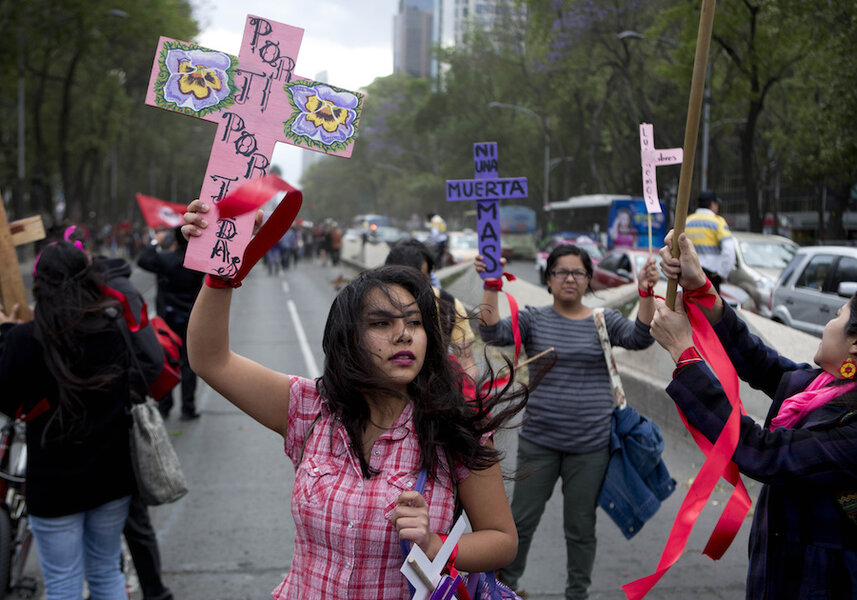Not a suicide: Mexico murder case challenges views of gender violence
Loading...
| Mexico City
Six years after Mariana Lima’s brutal death was labeled a suicide, her mother can finally exhale. She dedicated the past several years to campaigning for her daughter’s case to be reinvestigated, and last month her efforts resulted in the arrest of Ms. Lima’s former husband on charges of femicide.
It’s a grim victory for Lima’s family and the relatives of the tens of thousands of others in Mexico who have lost their lives to femicide – the deliberate killing of a woman based on her gender. And it’s an important moment for Mexico, part of a series of small but significant shifts in the landscape of violence against women here.
“This reinvestigation has become a platform from which we can expect all other cases of violent murders of women to be investigated with due diligence and a gender perspective,” says Rodolfo Domínguez, the lawyer representing Lima’s family.
There were more than 16,000 femicides – or roughly seven per day – in Mexico between 2008 and 2014. That makes it one of the worst countries for gender-based violence in the world, ranking worse than already notorious India. Endemic impunity means murders go unpunished here, with only 1.6 percent of femicides in 2012 resulting in sentences.
Lima’s case, despite evidence of strangulation and a marital history of rape and physical violence, represents a universal challenge in cases of femicide in Mexico: rates of generalized violence are high, tending to inure people, and views on gender are often skewed.
A recent survey by the National Autonomous University (UNAM) found that 88 percent of Mexicans believe “violence [is] a fact of daily life.” More than half of female respondents from Mexico state and Mexico City said they have experienced violence within the family, and 1 in 3 male respondents said it is acceptable to hit a woman “under certain circumstances.”
State governments are often criticized for being slow to publicly recognize the scale of the problem of female-targeted violence. Just last month, Mexico City Mayor Miguel Mancera was ridiculed when he proposed handing out whistles to women as a solution to warding off any unwanted attention.
But signs of changing views here are starting to emerge. They include a high-profile campaign against intimate partner violence by one of Mexico’s largest beer companies, Tecate, and an uptick in states implementing “gender violence alerts,” which give them the flexibility to roll out a series of emergency measures to improve safety for women.
“The existence of gender violence has become an irrefutable issue within public opinion,” says Laura Garcia, director of Semillas, a women’s rights NGO. “This is very clear progress as only a few years ago it was much easier for governments to deny that we live in a culture where violence against women is systematic.”
'The reality of violence'
Lima’s murder took place in Mexico state, which has one of the highest femicide rates in the country. A 2011 report by the attorney general’s office seemed to place the blame on women themselves, claiming they “get involved with multiple partners ... work in bars where they associate with clients ... and go out on their own late at night.”
“Their attitude was dreadful,” says Mr. Domínguez, the lawyer. “We reached a point where we weren’t going to seek any further contact with the authorities [on Lima’s case] as we saw no political will or intention to deal with the issue.”
But the Supreme Court ruled last year that Mexico state officials must reinvestigate Lima’s death taking femicide into consideration. It was the first time a Mexican court ruled that femicide should be the starting point for an investigation into a violent female death.
Although that victory came from the top-down, there have been plenty of grass-roots efforts as well.
Until a few years ago, gender alerts were written off as tools used solely to politically damage a state governor. The alerts, which can be called for by human rights organizations but only granted by state governments, trigger a series of emergency actions such as the creation of special victim units and dedicated investigation teams that allow authorities to address an immediate crisis. While they don’t pretend to attack the root of the problem, the alerts seek to lay the groundwork for later public policy efforts that target systemic change.
Public awareness campaigns, strategic lawsuits, and lobbying for femicide-specific legislation by NGOs like the National Citizens Observatory on Femicide have produced a flurry of gender-violence alerts in the past two years, with four now approved and a further eight under review.
“There is a saying in Mexico that dirty clothes should be washed at home, that gender violence should not be publicly discussed,” says Patricia Galeana, an academic involved in the UNAM gender survey.
But she’s noted signs that that “dirty laundry” is finally – if slowly – making its way into the public. Earlier this year, when a female journalist publicly denounced a man who groped her on the street in broad daylight, the reaction was explosive. Thousands of women took to social media to recount their own experiences with sexual harassment in Mexico.
“Ten years ago, no one talked about femicides," says Domínguez. "but by naming the reality of violence you can start to change it."







